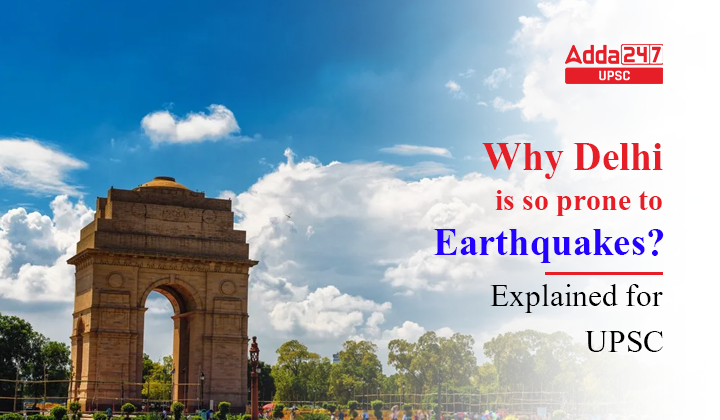Table of Contents
On the afternoon of Sunday, October 15, 2023, Delhi and the National Capital Region experienced significant tremors, reminiscent of the strong jolts felt on October 3. The seismic event on Sunday had an estimated magnitude of 3.1 and occurred at 4:08 p.m. The National Centre for Seismology reported that the earthquake originated in Faridabad, Haryana, at a depth of 10 kilometers. The epicenter of the quake was located nine kilometers east of Faridabad and approximately 30 kilometers southeast of Delhi.
Earthquake in Delhi-NCR
On October 15th, an earthquake with a magnitude of 3.1 occurred, leading to tremors in the Delhi-NCR region. The epicenter of this earthquake was located approximately nine kilometers from Faridabad in Haryana, with a depth of 10 kilometers beneath the surface. This seismic event followed a series of strong tremors experienced in several parts of North India, including Delhi, Punjab, Haryana, and Uttar Pradesh. These tremors were the result of a 6.2 magnitude earthquake that struck western Nepal, marking the strongest in a sequence of consecutive earthquakes affecting the region.
Why we are reading about Earthquakes in Delhi?
- Back-to-back tremors jolted the Delhi-NCR residents recently.
- The looming latent threat that the region faces from a massive earthquake is becoming more perceptible.
- The Delhi-NCR falls in the high-risk seismic zone and is prone to Earthquakes and these tremors should serve as a wake-up call for authorities to step up their disaster preparedness.
Recent history of earthquakes in Delhi
- Between September 2017 to August 2020, a total of 745 earthquakes have been recorded by the National Seismological Network, including 26 such events in the National Capital Region (NCR) with magnitude three and above on the Richter scale.
- In 2021, the Delhi-NCR region experienced tremors on at least five occasions after being hit by low-intensity quakes or because of aftershocks.
Why are frequent earthquakes happening in Delhi?
- Earthquakes are caused by the movement of the tectonic plates of the Earth, which means that the outermost layer of the planet’s surface is shaking.
- When two blocks of the Earth’s surface move against each other, it causes an earthquake.
- India experiences frequent earthquakes in the northern and northeastern regions because some parts of India and Nepal are placed on the boundary (fault zones) of two massive tectonic plates.
- The Indian plate moved towards the Nepalese plate, which led to the formation of the Himalayas. The collision of the two plates also made both countries vulnerable to earthquakes.
Why is Delhi so prone to Earthquakes?
- According to experts, Delhi’s geographical location makes it prone to frequent earthquakes, as it lies in the Himalayan foothills.
- Scientific studies have highlighted that the Indian plates are continuously driving towards the Eurasian plates at a rate of 5-6 cm per year.
- The Bureau of India Standards has classified the country into four major zones based on the macro seismic zoning map of India — Zone V (high intensity) to Zone II (low intensity).
- Parts of Delhi and northern Uttar Pradesh fall in Zone IV, which is the severe category.
- Gujarat’s Bhuj, which was struck by a massive earthquake in 2001 in which 20,000 people were killed, Chandigarh, Ambala, Amritsar, Ludhiana, and Roorkee all fall under zones IV and V.
- Delhi sits near three active seismic fault lines: the Sohna fault line, the Mathura fault line and the Delhi-Moradabad fault line.
- If these become active, it can cause a quake of 7.5 magnitude.
- Delhi is close to the Himalayas, which were formed by the mixing of tectonic plates such as India and Eurasia. Due to movements in these plates, areas like Delh-NCR, Kanpur, and Lucknow, are most prone to earthquakes.
What if a quake hits Delhi-NCR today?
- According to experts, there is consistent seismic activity going on in the NCR region, which can trigger big tremors.
- The border towns of Delhi have seen a rise in high-rise private buildings many of which do not follow mandatory guidelines set by the Bureau of Indian Standards (BIS) for earthquake-resistant construction.
- The numerous illegal colonies across the Capital and the shaky construction along the Yamuna will be unable to withstand a strong tremor.
- Everyone knows that Delhi-NCR falls under seismic zone-4, and it’s prone to tremors but still, most of the builders do not conform to the norms of BIS.
- On a Richter scale of 6.0, the effect of the earthquake in Delhi would be devastating. Many buildings would be razed to dust.
Which are the riskiest places in Delhi?
- According to a report on the “seismic hazard microzonation” of Delhi brought out by the Ministry of Earth Sciences, most places along the Yamuna and its flood plains, including the highly populated colonies of east Delhi, will be the worst hit if struck by a powerful earthquake.
- The Lutyens’ area, which houses the Parliament, central ministries, and other important structures, also falls under the high-risk zone along with Delhi University’s north campus, Karol Bagh, Janakpuri, Paschim Vihar, and Rohini.
- The Delhi airport and Haus Khaz fall under the second worst “high-risk category”.
Conclusion
Earthquake-resistant buildings in Japan have withstood the test of time and New Zealand is adopting base isolation techniques for old buildings. India has to learn a lesson or two from these experiences. Laws should be enacted which make seismic resistance an integral part of all construction. And these should be made compulsory. Proper checks should be carried out on each building every six months.



 TSPSC Group 1 Question Paper 2024, Downl...
TSPSC Group 1 Question Paper 2024, Downl...
 TSPSC Group 1 Answer key 2024 Out, Downl...
TSPSC Group 1 Answer key 2024 Out, Downl...
 UPSC Prelims 2024 Question Paper, Downlo...
UPSC Prelims 2024 Question Paper, Downlo...





